Jennifer Bohnhoff's Blog, page 36
May 31, 2018
Breaking up with Prince Charles
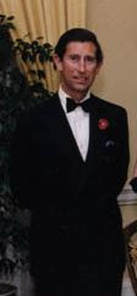 One of the big discussions about the recent marriage of Prince Harry and Meghan Markle centers on the fact that Ms. Markle is both an American and a commoner. But this isn't the first time an American commoner has made a bid for marriage with British royalty. I nearly did it myself forty years ago.
One of the big discussions about the recent marriage of Prince Harry and Meghan Markle centers on the fact that Ms. Markle is both an American and a commoner. But this isn't the first time an American commoner has made a bid for marriage with British royalty. I nearly did it myself forty years ago. In 1979, I had the unusual good fortune to study at the Centre for Medieval and Renaissance Studies in Oxford, England. Early in the Michaelmas, or fall, term, I bought a postcard, wrote a note to my mother, and posted it. Little did I know what a maelstrom I was unleashing.
I no longer remember the exact words that I wrote, but they went something like this: Dear Mum, I am having such a splendid time here. I have met the most wonderful man. He takes me to all the poshest places. He's introduced me to the most interesting of people. Next week I am going to London to have tea with his mother. I'm told she raises corgis. If I don't make it home for the holidays, do come to visit."
The joke was in the mention of corgis, since that is the kind of dog my family owned. Whenever anyone asked about our family's pet, a long haired Pembroke named Fluffy, my mother would proudly announce that she was the same kind of dog that Queen Elizabeth raised. I was sure my mother would get the joke.
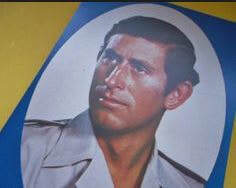 But she didn't.
But she didn't.Instead, my mother called my father on the phone and tearfully informed him that I was never coming home. My father, ever unflappable, asked her to read the postcard's note to him. He then told my mother to turn the postcard over. "It's a picture of Prince Charles, isn't it?" he asked, catching the joke immediately.
This threw my mother into an even bigger fit of pique. Not only was I marrying an Englishman and never coming home again, but that man was royalty! I'd be too busy with official state dinners and supermarket openings to even arrange a holiday visit!
My mother hung up on my father and called my boyfriend. Surely he could talk me out of this madness! Hank, ever willing to oblige my mother, caught a Freddy Laker flight to England that very weekend. When he returned, he informed my mother that all was well, and that I wasn't going to marry Prince Charles after all. A couple of weeks later, I wrote to my mother that Hank and I were engaged. I would return to America by Christmas and be married the next summer.
My mother really didn't breathe easily until Charles found someone else. About the same time that Hank and I married, news stories connecting Charles with a young woman named Diana Spencer began circulating. They were married a year after I married Hank, my own Prince Charming.
My marriage has fared much better than Diana's. After 38 years, we're still happy, and my mother continues to be grateful that Hank managed to steal me away from Prince Charles.
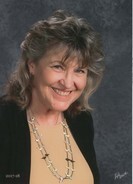 Jennifer Bohnhoff teaches middle school and writes historical fiction and other flights of fancy. Although none of her three sons will ever ascend to the throne, she and her Prince Charming of a husband live a fairytale existence in rural New Mexico. Their sole subject is a cantankerous cat and, sadly, they have never owned a corgi
Jennifer Bohnhoff teaches middle school and writes historical fiction and other flights of fancy. Although none of her three sons will ever ascend to the throne, she and her Prince Charming of a husband live a fairytale existence in rural New Mexico. Their sole subject is a cantankerous cat and, sadly, they have never owned a corgi You can read more of her blogs and get information about her books at www.jenniferbohnhoff.com
Published on May 31, 2018 11:53
April 3, 2018
Spartan Women
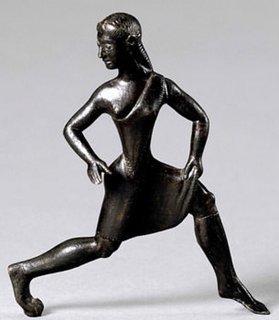 A bronze statue, likely of a Spartan woman. c. 500 BCE. (British Museum, London) image in the public domain. My sixth grade social studies classes are just finishing off a study of ancient Greece. One of the takeaways from our studies is that Spartan women had a better life than Athenian women.
A bronze statue, likely of a Spartan woman. c. 500 BCE. (British Museum, London) image in the public domain. My sixth grade social studies classes are just finishing off a study of ancient Greece. One of the takeaways from our studies is that Spartan women had a better life than Athenian women. Sparta didn't leave much historical documentation, so historians rely on Greek poets and historians to understand the lives of Spartan women. One Spartan who did leave records was Lycurgus, the Spartan to developed Sparta's legal system in the 7th century B.C. Lycurgus reorganized the political and social structure of the polis into the disciplined collective society that we commonly associate with Sparta. He included allowances for Spartan women that included a public education, the right to exercise and participate in athletic competitions, and the right to manage the money earned from their land. Spartan women were also allowed to appear in public and mingle with men. In the rest of the Greek world, women were largely confined to their own homes.
It occurred to me that one of the reasons that Spartan women had so much freedom was that their men were too busy with other things, namely war, to bother with micromanaging their women. This made me wonder: does the status of women rise when their men are busy waging war?
 This was certainly the case for American women during World War II. While their men were engaged in fighting in Europe, Africa and the Pacific, a large number of jobs, especially in munitions and manufacturing, opened to women. An example is the aviation industry. Before the war, just 1% of workers in aviation had been women. By 1943, a whopping 65% of the labor force was female. Granted, women did not have anything near pay parity during this period, but it was a start.
This was certainly the case for American women during World War II. While their men were engaged in fighting in Europe, Africa and the Pacific, a large number of jobs, especially in munitions and manufacturing, opened to women. An example is the aviation industry. Before the war, just 1% of workers in aviation had been women. By 1943, a whopping 65% of the labor force was female. Granted, women did not have anything near pay parity during this period, but it was a start.
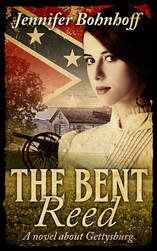 World War II wasn't the first time that opportunities for American women expanded because their men were at war. A similar experience happened during the Civil War. Not only did women find themselves in charge of keeping the home fires burning while the brother in blue fought the brother in gray, but they had to keep farms and businesses going. As men enlisted, two fields of endeavor, nursing and teaching, turned to women to fill the vacancies. The mother of Sarah McCoombs, the main character in my novel The Bent Reed, is determined that her daughter take advantage of this situation by training to become a teacher. Sarah, however, is interested in the healing properties of plants, especially the rapidly developing field of pharmaceuticals, which women had a significant role in developing.
World War II wasn't the first time that opportunities for American women expanded because their men were at war. A similar experience happened during the Civil War. Not only did women find themselves in charge of keeping the home fires burning while the brother in blue fought the brother in gray, but they had to keep farms and businesses going. As men enlisted, two fields of endeavor, nursing and teaching, turned to women to fill the vacancies. The mother of Sarah McCoombs, the main character in my novel The Bent Reed, is determined that her daughter take advantage of this situation by training to become a teacher. Sarah, however, is interested in the healing properties of plants, especially the rapidly developing field of pharmaceuticals, which women had a significant role in developing.I am not suggesting that women encourage wars so that they can get ahead while their men are off fighting. Now that the military is welcoming women into combat positions, this strategy wouldn't work anyway. And far more women are hurt by the ravages of war than are helped by the economic and social upheaval. But it is interesting that when the cat's away, the mice not only play, but thrive.
 When she's not writing historical fiction and other books for young readers, Jennifer Bohnhoff teaches 6th grade language arts and social studies in a rural town in central New Mexico.
When she's not writing historical fiction and other books for young readers, Jennifer Bohnhoff teaches 6th grade language arts and social studies in a rural town in central New Mexico.For more information on Jennifer's books, go here.
For more information on Spartan women, go here.
For more information on women in the WWII workforce, go here.
For more information about women's changing roles in the Civil War, go here.
For more information on the development of pharmaceuticals during the Civil War, go here.
Published on April 03, 2018 05:30
March 26, 2018
Spring Break: Books, Soldiers, and Peanut Blossoms through the generations
Although we are in different school districts, my granddaughter and I lucked out and had our spring breaks at the same time this year. To celebrate, she spent the night. When my granddaughter spends the night. We have a routine that is almost inviolate. We read stories and play games, take walks, and always, at her insistence, we bake cookies. 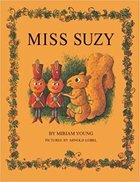 Last night, when I asked her which book she wanted to read, I wasn't surprised when she said "Nana, I want the one with the soldiers and the squirrel." Miss Suzy is an oldie, but a goodie, and it's one of her favorite books. It was one of my favorites when I was a child, and my sons enjoyed it a generation later, so it's no wonder my copy is falling apart. A book that's been handled, read and loved for three generations is a real keeper.
Last night, when I asked her which book she wanted to read, I wasn't surprised when she said "Nana, I want the one with the soldiers and the squirrel." Miss Suzy is an oldie, but a goodie, and it's one of her favorite books. It was one of my favorites when I was a child, and my sons enjoyed it a generation later, so it's no wonder my copy is falling apart. A book that's been handled, read and loved for three generations is a real keeper.
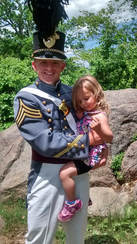 My granddaughter at my son's graduation from West Point, 2015 I think one of the reasons my granddaughter loves Miss Suzy is because of the brave toy soldiers who run off the thuggish red squirrels who had invaded Miss Suzy's home. My granddaughter loves soldiers, or more accurately, one soldier in particular: her Uncle John.
My granddaughter at my son's graduation from West Point, 2015 I think one of the reasons my granddaughter loves Miss Suzy is because of the brave toy soldiers who run off the thuggish red squirrels who had invaded Miss Suzy's home. My granddaughter loves soldiers, or more accurately, one soldier in particular: her Uncle John.
When my son graduated from West Point in 2015, my granddaughter was quite taken with his uniform. She gazed up at him and said "You are my tin soldier, and I am your ballerina." This grandma was proud, not only for her son's accomplishment or the love between family members, but for my then three year old granddaughter's ability to make literary allusions. I'm sure Hans Christian Andersen was smiling down from heaven.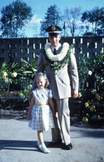 The author and her Uncle Jerry. This grandma understands a young girl's fascination with a man in uniform because she had her own love for a soldier, and like my granddaughter, my love was for an Uncle. My Uncle Jerry, my father's younger brother, was a bigger than life character to me. He was handsome and dashing, with a big laugh and a great sense of humor. He told fabulous stories and always seemed to be getting into situations that were both hilarious and a bit frightening. He was rough and tough, but gentle and sweet at the same time.
The author and her Uncle Jerry. This grandma understands a young girl's fascination with a man in uniform because she had her own love for a soldier, and like my granddaughter, my love was for an Uncle. My Uncle Jerry, my father's younger brother, was a bigger than life character to me. He was handsome and dashing, with a big laugh and a great sense of humor. He told fabulous stories and always seemed to be getting into situations that were both hilarious and a bit frightening. He was rough and tough, but gentle and sweet at the same time.
 Unwrapping the kisses. This morning we made a batch of Peanut Blossoms. Like Miss Suzy, these cookies have stood the test of time. They won the Pillsbury Bake-Off in 1957, and have been loved by generations of cookie fans. They are the favorite cookie of both my granddaughter and my soldier son. She made them for him while he was deployed, but just because he's returned to the states doesn't mean she'll stop making them for him. She'll be taking some home with her for her mom and dad. Some will end up in my husband's cookie jar and lunch bag. And some will be mailed to Fort Hood, where my son is currently stationed. I hope that you'll enjoy them, too. Oldies but goodies need to be shared. Peanut Blossoms
Unwrapping the kisses. This morning we made a batch of Peanut Blossoms. Like Miss Suzy, these cookies have stood the test of time. They won the Pillsbury Bake-Off in 1957, and have been loved by generations of cookie fans. They are the favorite cookie of both my granddaughter and my soldier son. She made them for him while he was deployed, but just because he's returned to the states doesn't mean she'll stop making them for him. She'll be taking some home with her for her mom and dad. Some will end up in my husband's cookie jar and lunch bag. And some will be mailed to Fort Hood, where my son is currently stationed. I hope that you'll enjoy them, too. Oldies but goodies need to be shared. Peanut Blossoms
 putting on the kisses 1 3/4 cups flour
putting on the kisses 1 3/4 cups flour
1/2 cup sugar
1/2 cup brown sugar
1 tsp baking soda
1/2 tsp salt
1/2 cup shortening
1/2 cup peanut butter
2 TBS milk
1 tsp vanilla
1 egg
Mix all ingredients in a mixer at low speed until a stiff dough forms. Roll into 1" balls. Roll in sugar and place 2" apart on an ungreased cookie sheet.
Bake at 375 for 10-12 minutes, or until golden brown. As soon as the cookies come out of the oven press a chocolate candy kiss into its middle, but not so hard as to split the cookie. Remove from cookie sheet and cool on a rack long enough for the kisses to reharden.
 Last night, when I asked her which book she wanted to read, I wasn't surprised when she said "Nana, I want the one with the soldiers and the squirrel." Miss Suzy is an oldie, but a goodie, and it's one of her favorite books. It was one of my favorites when I was a child, and my sons enjoyed it a generation later, so it's no wonder my copy is falling apart. A book that's been handled, read and loved for three generations is a real keeper.
Last night, when I asked her which book she wanted to read, I wasn't surprised when she said "Nana, I want the one with the soldiers and the squirrel." Miss Suzy is an oldie, but a goodie, and it's one of her favorite books. It was one of my favorites when I was a child, and my sons enjoyed it a generation later, so it's no wonder my copy is falling apart. A book that's been handled, read and loved for three generations is a real keeper.
 My granddaughter at my son's graduation from West Point, 2015 I think one of the reasons my granddaughter loves Miss Suzy is because of the brave toy soldiers who run off the thuggish red squirrels who had invaded Miss Suzy's home. My granddaughter loves soldiers, or more accurately, one soldier in particular: her Uncle John.
My granddaughter at my son's graduation from West Point, 2015 I think one of the reasons my granddaughter loves Miss Suzy is because of the brave toy soldiers who run off the thuggish red squirrels who had invaded Miss Suzy's home. My granddaughter loves soldiers, or more accurately, one soldier in particular: her Uncle John.When my son graduated from West Point in 2015, my granddaughter was quite taken with his uniform. She gazed up at him and said "You are my tin soldier, and I am your ballerina." This grandma was proud, not only for her son's accomplishment or the love between family members, but for my then three year old granddaughter's ability to make literary allusions. I'm sure Hans Christian Andersen was smiling down from heaven.
 The author and her Uncle Jerry. This grandma understands a young girl's fascination with a man in uniform because she had her own love for a soldier, and like my granddaughter, my love was for an Uncle. My Uncle Jerry, my father's younger brother, was a bigger than life character to me. He was handsome and dashing, with a big laugh and a great sense of humor. He told fabulous stories and always seemed to be getting into situations that were both hilarious and a bit frightening. He was rough and tough, but gentle and sweet at the same time.
The author and her Uncle Jerry. This grandma understands a young girl's fascination with a man in uniform because she had her own love for a soldier, and like my granddaughter, my love was for an Uncle. My Uncle Jerry, my father's younger brother, was a bigger than life character to me. He was handsome and dashing, with a big laugh and a great sense of humor. He told fabulous stories and always seemed to be getting into situations that were both hilarious and a bit frightening. He was rough and tough, but gentle and sweet at the same time.
 Unwrapping the kisses. This morning we made a batch of Peanut Blossoms. Like Miss Suzy, these cookies have stood the test of time. They won the Pillsbury Bake-Off in 1957, and have been loved by generations of cookie fans. They are the favorite cookie of both my granddaughter and my soldier son. She made them for him while he was deployed, but just because he's returned to the states doesn't mean she'll stop making them for him. She'll be taking some home with her for her mom and dad. Some will end up in my husband's cookie jar and lunch bag. And some will be mailed to Fort Hood, where my son is currently stationed. I hope that you'll enjoy them, too. Oldies but goodies need to be shared. Peanut Blossoms
Unwrapping the kisses. This morning we made a batch of Peanut Blossoms. Like Miss Suzy, these cookies have stood the test of time. They won the Pillsbury Bake-Off in 1957, and have been loved by generations of cookie fans. They are the favorite cookie of both my granddaughter and my soldier son. She made them for him while he was deployed, but just because he's returned to the states doesn't mean she'll stop making them for him. She'll be taking some home with her for her mom and dad. Some will end up in my husband's cookie jar and lunch bag. And some will be mailed to Fort Hood, where my son is currently stationed. I hope that you'll enjoy them, too. Oldies but goodies need to be shared. Peanut Blossoms putting on the kisses 1 3/4 cups flour
putting on the kisses 1 3/4 cups flour1/2 cup sugar
1/2 cup brown sugar
1 tsp baking soda
1/2 tsp salt
1/2 cup shortening
1/2 cup peanut butter
2 TBS milk
1 tsp vanilla
1 egg
Mix all ingredients in a mixer at low speed until a stiff dough forms. Roll into 1" balls. Roll in sugar and place 2" apart on an ungreased cookie sheet.
Bake at 375 for 10-12 minutes, or until golden brown. As soon as the cookies come out of the oven press a chocolate candy kiss into its middle, but not so hard as to split the cookie. Remove from cookie sheet and cool on a rack long enough for the kisses to reharden.
Published on March 26, 2018 19:08
March 13, 2018
An Interview With The Author
 Recently a high school student sent me an email requesting an interview. She needed to talk with someone who worked in a field in which she was interested. Here are her questions, and my answers. Let me know if you think I didn't explain the writer's life well enough. I'd love to learn how your answers would vary.
Recently a high school student sent me an email requesting an interview. She needed to talk with someone who worked in a field in which she was interested. Here are her questions, and my answers. Let me know if you think I didn't explain the writer's life well enough. I'd love to learn how your answers would vary.1. What made you decide to become a writer?
I don't think anyone decides to become a writer. Writers are compelled - driven by the stories that keep playing in their heads. They can't help themselves, and if they deny their writing it drives them crazy.
I started writing really young, like middle school, but I didn't start taking it seriously until I was a stay at home mom. Writing enabled me to go far, far away without having to hire a sitter.
2. I know becoming an author is a tricky job financially when you just get out of school because of getting your name out. Do you think newly graduated writers should work part time as a writer or submerge them self in their work?
I don't know anyone who was able to just submerge him or herself in writing. You either have to keep a day job, or find someone who will support you, or perhaps win the lottery. The exceptions to this are people who go into commercial writing, like copy editing, advertising, or journalism.
You mentioned an interest in editing, and that's a great way to break into the field, especially if you're willing to move to New York City. These days editors get paid a piddly salary to start out, but they make a lot of contacts and they're close to the big movers and shakers. Many editors write books to fill the "gaps" in their house's line, so they are both editors and writers.
3. What kind of experience did you have, or recommend, before going to college?
Live fully, travel widely, love deeply. And take lots of pictures to help jolt your memory later. I regret I did little of any of this before going to college.
4. How do you get out of creative blocks?
I've never had one. I've always had way more I wanted to write than time to write it in.
5. How do you pull yourself out of procrastination?
I usually don't. There's usually a reason why I'm not writing, and I respect that and do other things until I'm ready again. The story will start to beat on the inside of my head if I ignore it awhile, and usually when I procrastinate what I'm really doing is other stuff I need to get done (like laundry and weeding) while working out kinks in the plot twists.
6. What is your favorite genre to write in and why?
I love historical fiction, because I love researching the period and learning what was going on, how people lived, how they thought, and what they wanted. Some human feelings are universal. Others are not. That's always a surprise when I read primary sources.
7. Do you think living in New Mexico impacts your writing?
New Mexico is a cultural backwater in some respects, but the internet has opened the world up so much that it doesn't matter as much as it used to. And there's so much beauty here and so many untold stories. I think just looking out the window is inspiring.
8. Do you expand your creativity from just story book?
I'm not sure what you're asking here. Do I do other creative things besides writing? I'm a pretty fair cook, and I sing in the church choir but am not a fine enough talent in either to make a go of it professionally.
9. Are you self employed or do you work under a company?
Most writers don't work for companies. They are freelance, and when they've completed a novel (or other kind of book, fiction or nonfiction) they send it to editors of publishing houses and agents. Or, they self publish, which is what I do, because I gathered over 1,000 rejects and finally decided I didn't want to wait anymore and play the game. Getting published is hard. For every 10,000 manuscripts a publishing house gets, they're going to make an offer on one or two.
10. Do you see writing more as a serious or a fun job?
I have yet to have a serious job in my life. I won't do it if I can't find the fun in it. That being said, writing is rarely fun. It's hard work. Editing and rewriting is even harder. And getting rejected hurts. Deeply. But if you're meant to be a writer you do it anyway. And while not always fun, it can be thrilling and deeply satisfying.
Published on March 13, 2018 00:00
March 6, 2018
A Fort With Many Functions
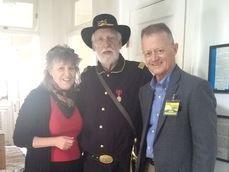 My husband and I with Rocky, one of the historical interpreters at Ft. Bayard As some of you know, my husband, Hank Bohnhoff, is a judge on the New Mexico Court of Appeals, and he has to run for election this year in order to keep his seat on the bench. Part of running for election is getting out and meeting constituents, and so we've been doing a lot of road trips this past year.
My husband and I with Rocky, one of the historical interpreters at Ft. Bayard As some of you know, my husband, Hank Bohnhoff, is a judge on the New Mexico Court of Appeals, and he has to run for election this year in order to keep his seat on the bench. Part of running for election is getting out and meeting constituents, and so we've been doing a lot of road trips this past year.Last month we visited the southwestern part of the state, and I had the joy of getting to make a short stop at Fort Bayard. I am always grateful when a trip includes a little history.
The Fort was named for General George D. Bayard, a West Point graduate who had been killed at Fredericksburg. Begun in 1866, the first fort constructed on the site was a collections of tents and crude adobe buildings thrown up by Company B the 125th United States Colored Infantry. Many of the soldiers stationed here were Buffalo Soldiers.

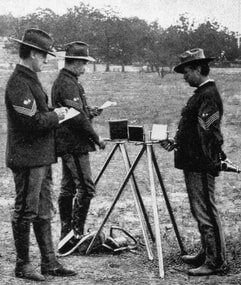 US soldiers were still using the heliograph in 1898, when this photo was taken. The fort protected settlements in Southern New Mexico from raids by the various Apache tribes who roamed the rugged mountains of the Gila. It was also one of 24 heliograph stations, which relayed messages between forts by means of the sun and a mirror that was used to flash out Morse code signals. Although less technologically advanced, the heliograph system worked better than the newly installed telegraph system, because the Apaches could cut telegraph wires but they could not meddle with the sun. It is of interest that the man charged with establishing the heliograph stations was a young Second Lieutenant named John J. Pershing, who would go on to become the famous Blackjack Pershing.
US soldiers were still using the heliograph in 1898, when this photo was taken. The fort protected settlements in Southern New Mexico from raids by the various Apache tribes who roamed the rugged mountains of the Gila. It was also one of 24 heliograph stations, which relayed messages between forts by means of the sun and a mirror that was used to flash out Morse code signals. Although less technologically advanced, the heliograph system worked better than the newly installed telegraph system, because the Apaches could cut telegraph wires but they could not meddle with the sun. It is of interest that the man charged with establishing the heliograph stations was a young Second Lieutenant named John J. Pershing, who would go on to become the famous Blackjack Pershing.
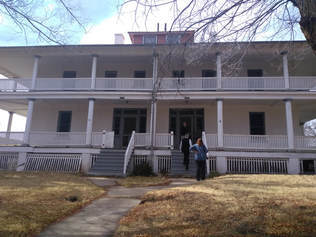 Some of the officer's housing. Once the Indian Wars were over, Fort Bayard became the first military sanatorium for the treatment of tuberculosis. Doctors at the time believed that high elevation, clean air, abundant sunshine and low humidity were all beneficial to the treatment of this disease. The Fort's population grew during World War I, when soldiers who had suffered from poisonous gas attacks crowded the wards. The nurses' quarters, which housed a matron responsible for the moral well-being of the women who tended the sick and injured, was relocated a distance from the other buildings after many nurses fell in love with patients.
Some of the officer's housing. Once the Indian Wars were over, Fort Bayard became the first military sanatorium for the treatment of tuberculosis. Doctors at the time believed that high elevation, clean air, abundant sunshine and low humidity were all beneficial to the treatment of this disease. The Fort's population grew during World War I, when soldiers who had suffered from poisonous gas attacks crowded the wards. The nurses' quarters, which housed a matron responsible for the moral well-being of the women who tended the sick and injured, was relocated a distance from the other buildings after many nurses fell in love with patients.During WWII, German Prisoners of War lived here, repairing buildings, tending the orchard, and caring for the burial grounds that became a National Cemetery in 1976. The fort continued to serve as a long-term care facility for veterans and civilians alike after it was transferred from Federal to State control in 1965. Finally, in 2010, a more modern medical facility was built just down the road.
Fort Bayard is set in a beautiful, mountainous setting, with wide, blue skies and big vistas. The buildings are in disrepair but to me, it is a glorious place, filled with historical narratives. It could be the setting for a "wild west" story, a love story between a young gas victim and a nurse, a story of longing for home by a young German POW. The possibilities are endless.
 My husband in Fort Bayard's cemetery. We found gravestones from the Spanish American War, World War I and II, Vietnam, and more recent conflicts.
My husband in Fort Bayard's cemetery. We found gravestones from the Spanish American War, World War I and II, Vietnam, and more recent conflicts.
Published on March 06, 2018 02:30
February 27, 2018
A Crockpot of Comfort
"The most remarkable thing about my mother is that for thirty years she served the family nothing but leftovers. The original meal has never been found." Calvin Trillin
I admit it; I love cooking with leftovers. I often cook more than I need, just so I'll have leftovers to turn into something else. For instance, turkey leftovers become enchiladas, several kinds of soup, crepes, and various casseroles, all of which I love more than the original roasted turkey.
I often cook two or three times as much rice as I need for a meal, just so I can have it for other recipes.
All this plan ahead cooking should give me more time to write, right?
I've toyed for years with the idea of coming out with a cookbook called Serial Cooking, which would be filled with recipes that piggyback off of other recipes - a series of meals much like Trillin's mother made. One of the times all that extra rice comes in handy is cold mornings, when I like to wake up and know that I've got something warm and comforting to entice me out from under the covers. One of my favorite go-to recipes for those kind of mornings is rice pudding. The Pokey Little Puppy ate rice pudding for desert, but for the Bohnhoffs, it's usually a comforting replacement for breakfast cereal.
Now that it's just my husband and me at home, I make it in a little crock pot that, I suppose, was intended for queso and other warm dips. I load it up after dinner and plug it in when I go to bed. In the morning my rice pudding is cooked and ready for me to spoon into a bowl. I pour milk over it and sprinkle sugar on top, then eat it like cereal.
If your family is larger, you can easily double or triple the recipe and use a standard sized crock pot.
Little Crockpot Rice Pudding
1 cup cooked, leftover rice (white or brown will work!)
3/4 cup milk (I use nonfat, but you can use whole milk for a richer taste.)
1/3 cup brown sugar
2 eggs
1 1/2 T melted butter
1 T vanilla
1/4 tsp. ground nutmeg
1/4 tsp. ground cinnamon
1/4 cup raisins, crasins, or other small dried fruit (cherries are good!)
Mix all together and pour into a lightly greased crock pot. Cover and cook on low overnight.
I admit it; I love cooking with leftovers. I often cook more than I need, just so I'll have leftovers to turn into something else. For instance, turkey leftovers become enchiladas, several kinds of soup, crepes, and various casseroles, all of which I love more than the original roasted turkey.
I often cook two or three times as much rice as I need for a meal, just so I can have it for other recipes.
All this plan ahead cooking should give me more time to write, right?
I've toyed for years with the idea of coming out with a cookbook called Serial Cooking, which would be filled with recipes that piggyback off of other recipes - a series of meals much like Trillin's mother made. One of the times all that extra rice comes in handy is cold mornings, when I like to wake up and know that I've got something warm and comforting to entice me out from under the covers. One of my favorite go-to recipes for those kind of mornings is rice pudding. The Pokey Little Puppy ate rice pudding for desert, but for the Bohnhoffs, it's usually a comforting replacement for breakfast cereal.
Now that it's just my husband and me at home, I make it in a little crock pot that, I suppose, was intended for queso and other warm dips. I load it up after dinner and plug it in when I go to bed. In the morning my rice pudding is cooked and ready for me to spoon into a bowl. I pour milk over it and sprinkle sugar on top, then eat it like cereal.
If your family is larger, you can easily double or triple the recipe and use a standard sized crock pot.
Little Crockpot Rice Pudding
1 cup cooked, leftover rice (white or brown will work!)
3/4 cup milk (I use nonfat, but you can use whole milk for a richer taste.)
1/3 cup brown sugar
2 eggs
1 1/2 T melted butter
1 T vanilla
1/4 tsp. ground nutmeg
1/4 tsp. ground cinnamon
1/4 cup raisins, crasins, or other small dried fruit (cherries are good!)
Mix all together and pour into a lightly greased crock pot. Cover and cook on low overnight.
Published on February 27, 2018 01:30
February 27th, 2018
"The most remarkable thing about my mother is that for thirty years she served the family nothing but leftovers. The original meal has never been found." Calvin Trillin
I admit it I love cooking with leftovers. I often cook more than I need, just so I'll have leftovers to turn into something else. For instance, turkey leftovers become enchilladas, several kinds of soup, crepes, and various casseroles, all of which I love more than the original roasted turkey.
I often cook two or three times as much rice as I need for a meal, just so I can have it for other recipes.
All this plan ahead cooking should give me more time to write, right?
I've toyed for years with the idea of coming out with a cookbook called Serial Cooking, which would be filled with recipes that piggyback off of other recipes - a series of meals much like Trillin's mother made.
One of the times all that extra rice comes in handy is cold mornings, when I like to wake up and know that I've got something warm and comforting to entice me out from under the covers. One of my favorite go-to recipes for those kind of mornings is rice pudding. The Pokey Little Puppy ate rice pudding for desert, but for the Bohnhoffs, it's usually a comforting replacement for breakfast cereal.
Now that it's just my husband and me at home, I make it in a little crock pot that, I suppose, was intended for queso and other warm dips. I load it up after dinner and plug it in when I go to bed. In the morning my rice pudding is cooked and ready for me to spoon into a bowl. I pour milk over it and sprinkle sugar on top, then eat it like cereal.
If your family is larger, you can easily double or triple the recipe and use a standard sized crock pot.
Little Crockpot Rice Pudding
1 cup cooked, leftover rice (white or brown will work!)
3/4 cup milk (I use nonfat, but you can use whole milk for a richer taste.)
1/3 cup brown sugar
2 eggs
1 1/2 T melted butter
1 T vanilla
1/4 tsp. ground nutmeg
1/4 tsp. ground cinnamon
1/4 cup raisins, crasins, or other small dried fruit (cherries are good!)
Mix all together and pour into a lightly greased crock pot. Cover and cook on low overnight.
I admit it I love cooking with leftovers. I often cook more than I need, just so I'll have leftovers to turn into something else. For instance, turkey leftovers become enchilladas, several kinds of soup, crepes, and various casseroles, all of which I love more than the original roasted turkey.
I often cook two or three times as much rice as I need for a meal, just so I can have it for other recipes.
All this plan ahead cooking should give me more time to write, right?
I've toyed for years with the idea of coming out with a cookbook called Serial Cooking, which would be filled with recipes that piggyback off of other recipes - a series of meals much like Trillin's mother made.
One of the times all that extra rice comes in handy is cold mornings, when I like to wake up and know that I've got something warm and comforting to entice me out from under the covers. One of my favorite go-to recipes for those kind of mornings is rice pudding. The Pokey Little Puppy ate rice pudding for desert, but for the Bohnhoffs, it's usually a comforting replacement for breakfast cereal.
Now that it's just my husband and me at home, I make it in a little crock pot that, I suppose, was intended for queso and other warm dips. I load it up after dinner and plug it in when I go to bed. In the morning my rice pudding is cooked and ready for me to spoon into a bowl. I pour milk over it and sprinkle sugar on top, then eat it like cereal.
If your family is larger, you can easily double or triple the recipe and use a standard sized crock pot.
Little Crockpot Rice Pudding
1 cup cooked, leftover rice (white or brown will work!)
3/4 cup milk (I use nonfat, but you can use whole milk for a richer taste.)
1/3 cup brown sugar
2 eggs
1 1/2 T melted butter
1 T vanilla
1/4 tsp. ground nutmeg
1/4 tsp. ground cinnamon
1/4 cup raisins, crasins, or other small dried fruit (cherries are good!)
Mix all together and pour into a lightly greased crock pot. Cover and cook on low overnight.
Published on February 27, 2018 01:30
February 20, 2018
Why thin air?
 I sell the majority of my books at craft shows. Often a shopper will stop to study the banner that hangs along the front of my table, then ask the question "Why Thin Air Books?"
I sell the majority of my books at craft shows. Often a shopper will stop to study the banner that hangs along the front of my table, then ask the question "Why Thin Air Books?"Good question.
 I created Thin Air Books to market my self published books after a group of other writers came to the conclusion that books sold better if they came from a publishing house. There are a number of reasons why I chose the name that I did.
I created Thin Air Books to market my self published books after a group of other writers came to the conclusion that books sold better if they came from a publishing house. There are a number of reasons why I chose the name that I did.When I started Thin Air Books, I lived in Albuquerque, New Mexico.
While Denver is known as the Mile High City, Albuquerque is also a mile above sea level. The air up here is pretty thin. It is even thinner on the top of the Sandias, the mountains that lay just east of Albuquerque. I used a picture of the snow covered Sandias, taken from my backyard, as the backdrop for the banner on the top of my website.
Since then, I have moved into those mountains. I live at nearly 8,000 feet - in rarefied air, indeed. The air is thin and dry enough that it cools off quickly at night. A bazillion stars spangle the heavens on a clear night. From my balcony I can see the lights of Santa Fe, and the Sangre de Cristo Mountains beyond.
 The view from my balcony.
The view from my balcony. 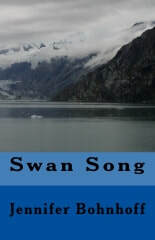 I do not pull my stories from thin air like a sleight-of-hand magician. The original concepts may come from my imagination, from an offhand comment in a conversation, or a single photograph, but I engage in a lot of research before my stories hit the market. For Swan Song, for instance, I had to follow the most current research on Neanderthal development and culture. Although
I do not pull my stories from thin air like a sleight-of-hand magician. The original concepts may come from my imagination, from an offhand comment in a conversation, or a single photograph, but I engage in a lot of research before my stories hit the market. For Swan Song, for instance, I had to follow the most current research on Neanderthal development and culture. Although the Neanderthals have been long dead, who they were and what they were capable of is currently a topic of hot debate among scientists. The research was interesting and evolving as I wrote. I also researched Beowulf commentary, recent terrorist activity, and date rape drugs. Authors have to know a lot of strange things if they want their books to ring true.
Published on February 20, 2018 07:30
February 13, 2018
a link in the chain
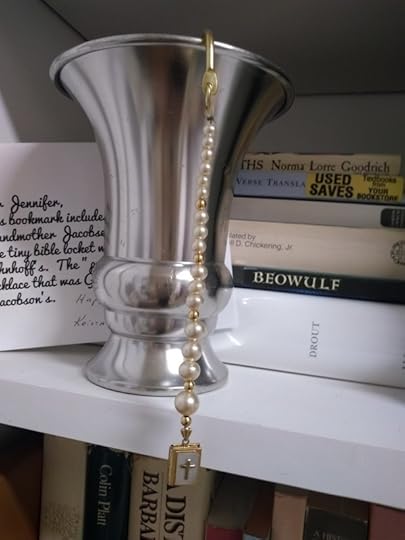 Two birthdays ago, my sister- in-law Krista gave me the bookmark that is hooked over this aluminum vase. The bookmark has a golden hook to insert into a book, and a chain of pearls and golden beads to dangle along the outside spine. The chain ends with a tiny locket shaped like a bible.
Two birthdays ago, my sister- in-law Krista gave me the bookmark that is hooked over this aluminum vase. The bookmark has a golden hook to insert into a book, and a chain of pearls and golden beads to dangle along the outside spine. The chain ends with a tiny locket shaped like a bible.It's a lovely bookmark, and I enjoy using it, but a couple of things make it even more special to me.
First, my sister-in-law made this
bookmark for me. To me, handmade gifts show a measure of thoughtfulness and care that store-bought gifts often don't. I know that as she selected the components of this bookmark and put them together, she was thinking about me. Krista "customized" her gift by inserting the bookmark into a book that she had chosen for me. It happened to be The Storied Life of A.J. Fikry., I very much enjoyed reading this novel. Looking at this bookmark will always bring it to mind.
But the real reason this bookmark is so special is the components from which it was assembled. Krista's mother - my mother-in-law - had given Krista a box of trinkets and nick-knacks from her mother and mother-in-law - Krista's maternal and paternal grandmothers. Krista took apart some of those things and reassembled them into this bookmark. The tiny bible locket belonged to my husband's paternal grandmother who had passed away before I was born. The pearls used to grace the neck of my husband's maternal grandmother, whom I met when my husband and I were dating, but passed away before our marriage. I know this because Krista was kind enough to include a note explaining this to me.
This bookmark isn't just a reminder of my sister-in-law's kindness in making it for me. It is a link to women two generations back, uniting me in a chain of women that flow back through the ages, and forward through ages to come. Someday i will pass it on, either to one of my daughters-in-law or to a granddaughter.
And the chain will remain unbroken.
Published on February 13, 2018 06:00
February 6, 2018
Bent's Fort: Important Historical Landmark
 My husband and friend approach the fort. One of the historical places of interest I visited this summer was Bent's Old Fort. Located outside of La Junta, Colorado, the fort, originally built by Bent, St. Vrain & Company in 1833, was rebuilt by the National Park Service in 1975, faithfully following sketches made by James W. Abert, an Army officer who stayed at the fort while recovering from an illness. The fort was built just north of the Arkansas River, which at the time was the boundary between the United States and Mexico. Spain had lost control of Mexico in 1821, and Mexico had opened trade with America. Charles and William Bent, sons of a St. Louis judge, had come west to earn their fortunes in the fur trade. Together with Ceran St. Vrain, the son of French aristocrats who had come to America to escape the French Revolution, they formed a trading company and built the fort to be its base of operations. The fort traded for beaver pelts and buffalo hides brought in by the Indians, for hardware, glass, silver, blankets, axes, firearms, horses, and mules. The company dominated the Indian trade on the southern plains and was an important stop on the newly opened Santa Fe Trail.
My husband and friend approach the fort. One of the historical places of interest I visited this summer was Bent's Old Fort. Located outside of La Junta, Colorado, the fort, originally built by Bent, St. Vrain & Company in 1833, was rebuilt by the National Park Service in 1975, faithfully following sketches made by James W. Abert, an Army officer who stayed at the fort while recovering from an illness. The fort was built just north of the Arkansas River, which at the time was the boundary between the United States and Mexico. Spain had lost control of Mexico in 1821, and Mexico had opened trade with America. Charles and William Bent, sons of a St. Louis judge, had come west to earn their fortunes in the fur trade. Together with Ceran St. Vrain, the son of French aristocrats who had come to America to escape the French Revolution, they formed a trading company and built the fort to be its base of operations. The fort traded for beaver pelts and buffalo hides brought in by the Indians, for hardware, glass, silver, blankets, axes, firearms, horses, and mules. The company dominated the Indian trade on the southern plains and was an important stop on the newly opened Santa Fe Trail. 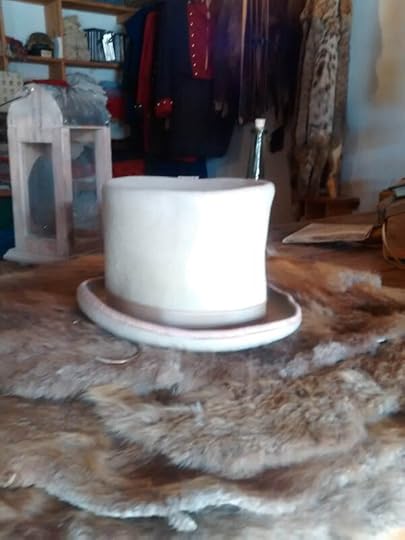 A beaver hat sitting on a pile of beaver pelts.
A beaver hat sitting on a pile of beaver pelts.
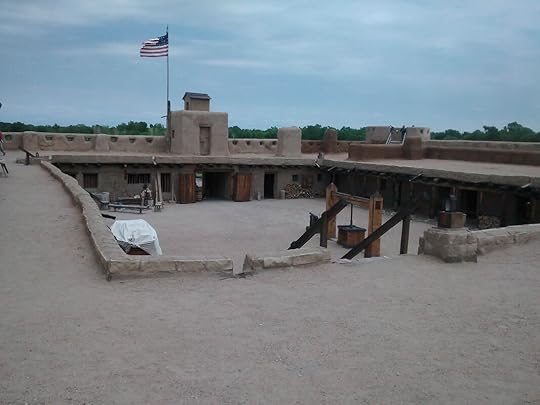 Looking into the interior.
Looking into the interior.  The fort's trading post. In 1835, the fort was the site of a peace council between the Cheyenne and Arapaho, and their old enemies, the Pawnee. The fort was also instrumental in getting much of Mexican territory into American hands. In 1848, Colonel Stephen Watts Kearny used the fort as an advance base for his invasion of New Mexico.
The fort's trading post. In 1835, the fort was the site of a peace council between the Cheyenne and Arapaho, and their old enemies, the Pawnee. The fort was also instrumental in getting much of Mexican territory into American hands. In 1848, Colonel Stephen Watts Kearny used the fort as an advance base for his invasion of New Mexico.Going to the fort now is like stepping back in time. Visitors are greeted by a guide in 19th century clothes. The smell of a cottonwood campfire decreases the heady smell that comes from the stables at the back of the fort. Blacksmiths and others go about their day to day duties.
It is open year round and has special events scheduled seasonally.
Bent's Fort is a great place to experience what it was like to live on the plains in the middle 1800s.
Published on February 06, 2018 00:00



